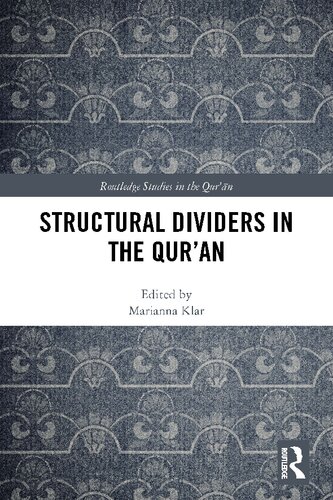

Most ebook files are in PDF format, so you can easily read them using various software such as Foxit Reader or directly on the Google Chrome browser.
Some ebook files are released by publishers in other formats such as .awz, .mobi, .epub, .fb2, etc. You may need to install specific software to read these formats on mobile/PC, such as Calibre.
Please read the tutorial at this link: https://ebookbell.com/faq
We offer FREE conversion to the popular formats you request; however, this may take some time. Therefore, right after payment, please email us, and we will try to provide the service as quickly as possible.
For some exceptional file formats or broken links (if any), please refrain from opening any disputes. Instead, email us first, and we will try to assist within a maximum of 6 hours.
EbookBell Team

4.8
54 reviewsThis volume showcases a wide range of contemporary approaches to the identification of literary structures within Qur’anic surahs. Recent academic studies of the Qur’an have taken an increasing interest in the concept of the surah as a unity and, with it, the division of complete surahs into consecutive sections or parts.
Part One presents a series of case studies focussing on individual Qur’anic surahs. Nevin Reda analyzes the structure of Sūrat Āl ʿImrān (Q 3), Holger Zellentin looks at competing structures within Sūrat al-ʿAlaq (Q 96), and A.H. Mathias Zahniser provides an exploration of the ring structures that open Sūrat Maryam (Q 19). Part Two then focusses on three discrete aspects of the text. Nora K. Schmid assesses the changing structural function of oaths, Marianna Klar evaluates how rhythm, rhyme, and morphological parallelisms combine in order to produce texture and cohesion, while Salwa El-Awa considers the structural impact of connectives and other discourse markers with specific reference to Sūrat Ṭāhā (Q 20). The final section of the volume juxtaposes contrasting attitudes to the discernment of diachronic seams. Devin Stewart examines surah-medial oracular oaths, Muhammad Abdel Haleem questions a range of instances where suggestions of disjointedness have historically been raised, and Nicolai Sinai explores the presence of redactional layers within Sūrat al-Nisāʾ (Q 4) and Sūrat al-Māʾidah (Q 5).
Bringing a combination of different approaches to Qur’an structure into a single book, written by well-established and emerging voices in Qur’anic studies, the work will be an invaluable resource to academics researching Islam, religious studies, and languages and literatures in general.
Chapter #6 of this book is freely available as a downloadable Open Access PDF under a Creative Commons Attribution-Non Commercial-No Derivatives 4.0 license available at http://www.taylorfrancis.com/books/e/9781003010456